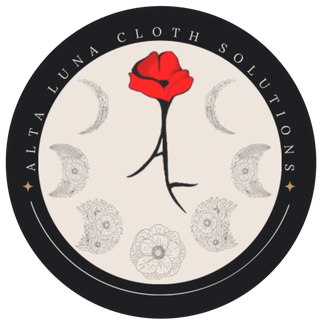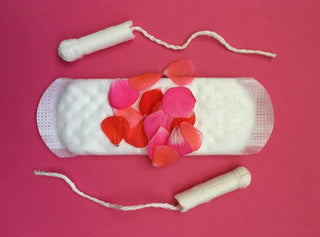The Facts:
Environmental
- In the US, in 2018, 5.8 billion tampons were bought.
- An average American menstruator will use between 5 and 15 thousand pads and tampons over the course of their life.
- Disposable pads are comprised of over 90% plastic.
- Tampons, not counting the applicator or the wrapper which are both 100% plastic, are 6% plastic.
- Plastic takes anywhere from 20 to 1000 years to “decompose” into micro and nano plastics.
- The average timespan of menstruation can last 30 to 40 years (from puberty to menopause, ~12 to 45).
- A menstrual cycle lasting 5 days per month for 30 to 40 years can add up to 5 to nearly 6 years of menstrual bleeding altogether over the span of a lifetime.
- At 5 product changes per day that is upwards of 9,000 and 12,000 disposable products discarded by every menstruator in their lifetime.
Biological
- Harmful VOCs and Phthalates are found in most if not all mainstream disposable diapers and menstrual pads.
- VOCs increase the risk of brain impairment, asthma, disabilities, certain cancers, and the proper functioning of the reproductive system.
- Phthalates have been linked to endocrine disruption, heart and reproductive issues, diabetes, some cancers, and birth defects.
- The mucosa of the vaginal area increase absorption of these harmful chemicals exponentially.
- Vaginal absorption is a direct route to the blood stream bypassing the body’s natural filtration system.
- Prolonged exposure (5 to 6 years) enormously increases the chances of serious and/or fatal health consequences.
- Tampons and disposable pads contain undisclosed ingredients such as plasticizers, chemical fragrance, and even pesticides.
- Cramping, bleeding amount and severity can be affected in addition to the health concerns mentioned above.
Financial
- A box of 18-20 tampons (regardless of absorbency) costs anywhere from $4 to $7 in the US. Average cost ~ $0.30 per tampon
- A box of 20 pads (not pantyliners) goes for about $6 to $12 dollars. Average cost ~ $0.40 per pad.
- At 30 cents per tampon that’s anywhere between $2,700 and $3,600 for tampons over a lifetime, at least. (9,000 to 12,000 product changes)
- at 40 cents per pad that’s $3,600 to $4,800 in a lifetime.
On a positive note
- According to Healthline.com a menstrual cup can last up to 10 years. At roughly $30 each that’s up to $120 in a lifetime.
- A reusable menstrual pad can last up to a decade as well. If you had a pad for every change in a cycle you would have about 25 cloth pads (5 changes per day for 5 days per month = 25 changes per month).
- The average cloth pad is anywhere between $5 and $30 depending on so many factors.
- At $20 per pad an initial investment c ould cost $500. A lifetime investment could roughly be $2,000.
The Solutions?
You’re already doing it! Whether you’re here because of some great and burning passion driven by need or responsibility, cruising reusables because you are transitioning your lifestyle little by little, want to support small businesses, or are merely curious and want to learn more you’re here aren’t you? That at least is a start. Regardless of your main concern, or concerns, every little bit counts. Every pad or tampon that isn’t bought or used and doesn’t make its way into our soil and oceans is a win. The economic pressure is slowly causing a shift in the way manufacturers make their products and the materials they use. For every hour of your life you keep harmful chemicals and plastics away from your reproductive organs you’re improving your long term health. The wisdom we bear creates cultural shifts, from easy consumerism to educated sustainability, and the lessons we learn and teach today will hopefully carry on for generations. And for every dollar you save, well, that one is pretty self explanatory I think.
For more information and further reading checkout these articles:
Single Use Plastic in Period Products
Hidden Ingredients in Our Period Products
How Tampons and Pads Became Unsustainable
Everything You Need to Know About Menstrual Cups
How Tiny Plastic Particles Are Polluting Our Soil


